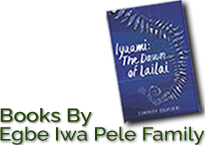Wakanda is Real
Paleo -Science, The Mysteries of Creation, revealed by our African Ancestors as preserved in the oral scripture of traditional Yoruba culture called Odu Ifà
By Awo Falokun Fatunmbi
Chapter 2
Ifà the Ancestral Wisdom of Ancient Yoruba Culture
An examination of a single ancient African culture gives perspective on the level of deception propagated by the accepted academic narrative on Africa history.
Ifà is the Yoruba word for wisdom.
Yoruba culture is the foundation of an ancient civilization centered in Southwest Nigeria. Elements of the culture spread north of Nigeria into Benin and south of Nigeria into Cameroon. The splitting of the original kingdom across the boundaries of three countries was a result of the arbitrary creation of Nations by the Berlin council of 1886.
The region known as Yorubaland is made up of six regions recognized as states by the Nigerian civil authority. These states are called:
Ekiti
Lagos
Ògún
Ondo
Osun
Oyo
Academic historians date the beginning of Yoruba culture at 1,500 B.C.E. making it 3,500 years old. The Yoruba people have their own calendar. The calendar dates back 10,500 years. The apparent academic rejection of the evidence of this calendar appears to be based on fact it predates European calendars by 8,000 years. In other words, it does not conform to the academic belief culture started in Greece. The dismissal of the date created by Yoruba culture for the origin of Yoruba culture can only be described as the dismissal of data because it causes discomfort within those institutions used to justify European colonialism.
The western concern over emotional reactions being more important than objective data, undermines the viability of western academic sources describing African history. It would be fair to describe these sources in reference to this history as questionable.
For researchers who have been to Africa, for researchers who are willing to consider African oral history as a real description of actual events, for those who have the ability to see evidence of extremely advanced culture, science, architecture, engineering, and advanced theoretical thinking, the idea Wakanda is artist reference to real history is a source of psychic dissonance and not a source of critical analysis.
Currently the Yoruba Kingdom is located in a country called Nigeria. There once existed proof of both the antiquity and sophistication of various cultures in this region of Africa. A clear example of this proof is photographic evidence of eleven ancient pyramids located on the Edi highlands known as the Nsude pyramids. These structures were located in what is now an area populated by Igbo culture.
The first Western archeologist to describe the Nigeria pyramids was Luke Walter. His research led to further exploration by G.I. Jones in 1935. Jones photographed one large pyramid surrounded by ten smaller pyramids. These structures were made from the red soil commonly found throughout the region. Due to deliberate desecration all that remains of these ancient monuments are piles of rubble. As proof this desecration was deliberate western academia does not identify the specific location of these structures.
Based an examination of the photographs taken by G.I. Jones, the largest pyramid was similar to the stepped pyramids in Egypt and the smaller pyramids where identical to pyramids found in India called Stupas. Notes taken by early British archeologists identify the village where they stayed while studying the ancient artifacts. Local custom reports that the guardians of the pyramids used red soil to repair damage and corrosion. The British government banned the repair of the Nsude pyramids and evidence of their location has been erased.
Western academics claim there is no record of the purpose of the Nigerian structures. This claim is a deliberate deception. It is based on the apparent need of western academia to deny the scientific and spiritual contributions originating in Africa. Western academia takes the position that Africa made no contributions to the human effort to understand self and world. All evidence to the contrary is either dismissed, ignored, distorted, or destroyed.
The largest of the pyramids in Nsude is dedicated to the spirit of Ala. The word Ala is a cross cultural word used throughout Africa to describe what Nikola Tesla called a longitudinal beam of light. Based on his understanding of the longitudinal beam of light Tesla was able to generate and transmit electric energy using the frequencies generated by the movement of the earth. This same principle was used in Ancient Egypt to produce energy at Giza.
According to Christopher Dunn, in his book Giza Power Plant, ancient pyramids were built over underground rivers and were used to store electricity generated by the subterranean movement of water. According to Tesla, the structure of the pyramids created a frequency that shifted a longitudinal light beam into a light wave. Tesla’s students refer to a longitudinal light beam as a source of zero-point energy. Patents created by Tesla show how he was able to transform a longitudinal light beam into a form of micro-wave energy by placing coils directly above underground aquafers. Dunn makes a detailed analysis of how microwave energy was produced by mixing chemicals inside the Giza Pyramid. Tesla placed light bulbs in the ground surrounding his towered coils and the bulbs lit up with no wire attachments to the power source.
The work of Tesla and Dunn proves ancient Africans understood this process in ancient times.
There is a lighting system depicted on the wall of the Hathor Temple in the Dendera Temple complex in Egypt. Academia claims the inside structures of pyramids and stone temples were built using torches. Light from a fire source leaves scorch marks. No scorch marks have ever been found in ancient Egyptian stone structures. There are images of alternative light sources carved into ancient Egyptian hieroglyphics inscriptions. In academia when original sources do not match the accepted narrative, the original sources are ignored.
At the Dendera Temple in Egypt there are images clearly representing flying aircraft. Modern Egyptologists covered those images with cement.
In traditional African cultures, across the continent, a longitudinal light beam is called Ala. It is a source of illumination, and it is believed to be a carrier of the blueprint for all of Creation. In modern quantum physics the idea of light carrying the Blueprint of Creation is called the holographic theory of Creation.
According to western academic narrative that rejects the ideas of quantum physics, there is no such thing as a longitudinal light wave. This denial is based on the deliberate distortion of the theories presented by James Clerk Maxwell (1831 – 1879).
Maxwell created the theory of light as a manifestation of electromagnetic impulses in Nature. Using data collected by Michael Faraday, Maxwell was able to chart electromagnetic lines of force by measuring their frequency. Maxwell’s theory is rooted in the idea that a longitudinal beam of light has no frequency. The longitudinal beam of light becomes a light wave once it establishes motion in a consistent pattern based on the influence of gravity. According to Maxwell, a longitudinal light beam is the source of light frequency as a component of the relationship between electricity and magnetism forming an electromagnetic polarity that is basis for the universal structure of everything in Creation.
Ifà describes the light of Ala, or the longitudinal light beam as coming from the center point of Creation called oyigioyigi from the elision o yigi o yigi. The word yigi in Yoruba means to divorce or separate. The later O in front of a liturgical Yoruba word means the Spirit of the thing being described. When a word is repeated in the Yoruba language it means the original source of the thing being described. Oyigioyigi is a symbolic reference to the moment the singularity of Creation split and generated diversity in Creation. It is the point of separation between the visible and invisible realms of reality in Yoruba known as Orun and Aye.
The idea of a longitudinal light beam as described James Clerk Maxwell became a foundational component of what is known in the west as quantum physics. The same idea is expressed in ancient Ifà paleo-science as Ala.
The reason this comparison is never made in academia is based on deliberate suppression of the theories of James Clerk Maxwell.
Shortly after Maxwell published his analysis of electromagnetic frequencies, British academia asked an electrical engineer names Lee Heavenside to re-write the Maxwell equations so they could not be used to identify the frequency generating zero-point energy. The information related to the distortion of Maxwell’s research appears to have been scrubbed by the internet. If you research the table of frequencies originally created by Maxwell, the equation related to zero-point energy is redacted with a foot note saying the information is deleted for reasons of National Security.
Western academia has censored the theoretical work of Maxwell. Instead, they support the revisions of Maxwell’s analysis written by Lee Heavenside. Maxwell had academic credentials, Heavenside did not.
The smaller ancient pyramids photographed in Nigeria by G.I. Jones were circular.
Based on old photographs there appeared to be five of them. They are identical to circular pyramids located around the world. In India, these small circular pyramids are called Stupas.
Western academia claims no one knows either the function or symbolic meaning of ancient circular pyramids. In contradiction to this assertion, Laird Scranton has done a cross cultural examination of sacred literature in Africa, China, India, and the Middle East and has discovered all of these cultures describe circular pyramids in the same way. In his book Point of Origin, Scranton uses language analysis to make the point circular pyramids are symbolic representations of the idea of the ascension or elevation of consciousness. He also makes the point that the geometry of the circular pyramid includes ratios used to describe one of the fundamental pattern of expansion known in western science as the Fibonacci curve.
In the cultures Scranton studies, ascension is associated with enlightenment symbolized by the image of a seashell. The seashell is a graphic, symbolic representation of the Fibonacci curve.
The oral traditions of the area where the stupas are located, in what is now called Nigeria, describe enlightenment as coming from the light of Ala. The largest of the pyramids in ancient West African Pyramid is dedicated to the Spirit of Ala or the Source of enlightenment. All of this information is available to western academics who choose to ignore it.
In the north African Dogon culture, the geometry of the Stupa is used to explain the process of a light wave becoming a light particle. The Dogon describe light as moving through three dimensions of reality in the process of creating matter. The Dogon’s symbolize the movement from light wave to light particle as the creation of a clay pot called toro nomo. In the Yoruba language this transformation occurs in a container called Odu a word with the dual meaning of womb and pot.
In Ifà symbolic language the three stages for a light wave to become a light particle are symbolized by a white circle becoming a red circle, becoming a black circle. This color coding is a fundamental system for organizing data in Ifà oral scripture.
In Vedic traditions the process of ascension or enlightenment is called Sakti. Access to the power of Sakti is described as coming from the ability to meditate in the sensory deprived environment created by a Stupa. The energy creating enlightenment is described in Vedic texts as coming from the earth, flowing through the body and emerging from the top of the head. This energy is called shakti. This process is described as being facilitated by the geometric shape of a Stupa.
In traditional Yoruba culture enlightenment is described as coming from the earth and flowing through the top of the head. The Yoruba word for the top of the head is called ori also meaning consciousness.
The Yoruba’s call the energy of shakit, ase. Yoruba metaphysics describes ase as coming into the physical body from the earth and moving through the body until it emerges through the top of the head. This process is known as the journey of the ori towards the Èlà or the journey of the self towards the higher self. Initiates who experience this ascension are described as being possessed by the spirit of Èlà. The word Èlà is from the elision e ala meaning I am the light.
Ascension, elevation, and the expansion of consciousness cross culturally is based on the idea of living in a dual universe. In ancient Yoruba cosmology this duality is called Orun, the invisible work and Aye, the visible world. In simple terms the invisible realm is the source of inspiration for the manifestation of reality in the visible realm through the medium of time and space.
The cultures using a circular pyramid as a place of meditation and enlightenment claim the function of these structures is enhanced during specific times of the year.
The concept of energy emerging from the earth in varying levels of intensity has been explored and documented by Freddy Silva. In his books on ancient sacred sites, he correlates these sites with gravitational anomalies. Using NASA satellite data, Silva shows how there is periodic decrease in gravitation pull along a complex earth grid that was used in ancient times to position the construction of sacred sites used for initiation. The point he is making is a decrease in gravity shifts the frequency of consciousness.
The original purpose of astrology was to mark the times and places where these gravitational anomalies occurred. The anomalies are believed by astrologers to be the result of the variation of gravitational pull on the earth created by the movement of the sun, the moon and the planets that circle the sun.
The Yoruba scholar Oluwatoyin Vincent Adepoju has charted the location of temples at the Osun Grove in Nigeria and has shown how they are aligned to the planet Venus.
The relationship between astrology, sacred sites, and the gravitational influence of astral bodies is at the foundation of alchemy.
The Western academic narrative claims there is no such thing as alchemy.
All of the gold discovered on statues in Egypt is artificial, meaning made through what the ancient Egyptians called alchemy. The only known way to place gold on a statue is through a process called electro-plating. The gold covering King Tuts coffin can only have been placed on the wooden foundation of the coffin through the use of electricity.
Alchemy was widely understood and practiced in ancient times. One of the telltale signs an ancient culture understood the deeper mysteries of metallurgy is the ability of a culture to create iron that does not rust. In the center of the Yoruba city named Ile Ifé there is an obelisk dedicated to the Spirit of Oranmiyan. Towards the top of the obelisk there are sixteen iron nails pounded into the stone in the shape of a trident. The nails show no evidence of rust.
Western academia claims the obelisk is 1,500 years old. Chief Wande Abimbola claims it is much older. Even using the conservative age estimate, the absence of rust is proof of a knowledge of alchemy.
The idea ancient Africans developed a sophisticated scientific perspective is more than speculation. As evidence, the Shabaka Stone in Egypt is a unique Hieroglyphic written on papyrus by King Shabaka, son of King Piye, the founder of the 25th Dynasty. According to professor Kaba Kamene the text carved into the stone is a reference to an idea developed in Pre-Dynastic Egypt. Kaba Kamene describes the ShabakaStone Hieroglyphic images as a symbolic representation of the Big Bang Theory of Creation.
(https://www.afrikaiswoke.com/shabaka-stone-the-big-bang-dr-oyibos-grand-unified-field-physics-theorem/)
Mathematician Dr. Gabriel Oyibo uses an idea symbolized by the Shabaka Stone as the basis for his conceptualization of Unified Field Theory. In Western Science, Unified Field Theory is the integration of quantum physics, particle physics and astrophysics. It is the idea that one set of mathematical relationships can be used to describe dynamics and form through the visible universe. Unfortunately for western science these three forms of physics appear to be based on separate disconnected laws of nature.
According to Dr. Oyibo the Shabaka Stone is a symbolic representation of the primal principles of Creation; the Nun and Naunet (above and below), the Huh and Hauhet (infinite and finite), and the Kuk and Kauket (darkness and light.)
The Shabaka Stone represents primal forces described in ancient times as having created the Atum (atom). According to Dr. Oyibo the image on the stone, the division of Atum manifests the fundamental elements of Creation: Shu (air), Tefnut (moisture), and Nut (sky). These fundamental elements are described as giving birth to: Osiris (the God of omnipotence and omniscience or the principle of the conservation of matter), Isis (the female principle the transformation of light into matter), and Nephthys (the invisible source of the structure of matter).
A theoretical analysis of the Shabaka stone shows ancient Africans had a cohesive cosmology based on the idea Atum or atom as the fundamental building block of Creation. From an ancient African perspective, Atum came into Being as an expression of Divine Consciousness that created vibrational patterns of sound called Heka that shapes reality. These patterns are the basis for what Western Science called quantum physics. It is the idea sound creates frequency, frequency creates color, color creates shape all as an integrated continuum of a single primal impulse.
The study of quantum physics uses what is called the Plank Constant. The theory of the Plank Constant is a pattern used to measure the size and shape of atoms. It is a complex mathematical formula.
There is in a remote area of the Egyptian Desert called Nata Playa there a stone map of the night sky. Buried six feet below this map is a map of the solar system. Buried six feet below this map is a stone structure with proportions identical to Plank’s Constant, the fundamental theory of western quantum physics.
Western academics call this a coincidence. The question is how many coincidences does it take to establish a conscious idea?
The acceptance of Plank’s Constant by the academic founders of quantum physics led to a debate between Albert Einstein and Niels Bohr in 1927. Einstein took the position that the interactions of subatomic particles were mechanistic, and they could be both measured and predicted. Bohr argued the interaction of subatomic particles was based on probabilities and not certainties. Bohr’s observations led to the idea subatomic particles have consciousness and their movements are influenced by the perspective of the observer.
These two points of view are incompatible.
Einstein spent thirty years trying to reconcile the mechanics of quantum physics with the mechanics of particle physis used as the basis for astral physics. The effort at reconciliation is called Unified Field Theory. Einstein failed in his attempts to establish a compelling Unified Field Theory and the different branches of physics remain separate and isolated in western academia.
Dr. Gabriel Oyibo is a Nigerian aeronautical engineer and mathematician who received a PHD from the Rennselarer Polytechnic Institute in Troy, New York in 1980. He used his study of the Shabakastone to formulate an equation he calls GUGUT, meaning the “God Almighty Grand Unified Thesis.” Dr. Oyibo created equations based on his study of the sound frequencies created by the Egyptian deity Hekau and the Egyptian description of the creation of the primal atom called Atum. These equations are based on the idea that the original manifestation of the atom was the formation of the Hydrogen atom. The creation of the Western Scientific Periodic Table is according to Dr. Oyibo the result of increased expressions of complexity in the structure of Hydrogen.
The mathematical formular for Dr. Oyibo’s theory of GUGUT was published and peer reviewed leading to his nomination for a Noble Prize.
Dr. Oyibo stated the inspiration for his theoretical ideas was inspired by both the ancient wisdom of Egypt and by the theoretical ideas he learned from his Ifà elders in Nigeria.
A thorough examination of Dr. Oyibo’s observations regarding the transformation of the primal Hydrogen Atom is the theoretical basis for ancient Africa paleo-science. It is also the basis for the theory and practice of Alchemy.
The notion subatomic particles have consciousness including the ability to make choices is at the foundation of both African paleo-science and western quantum physics.
The idea all of Creation has consciousness leads to the foundation of the ancient African paleo-science process of discovery. This process is the foundation of Ifà spiritual discipline based on the development of Iwa pele. The word Iwa pele is from the elision Iwa ope ile meaning I come to greet the Earth. The implication of the word is that human lIfé greets the Earth in order to learn from the Earth. Ifà teaches the idea that we learn from the Earth by communicating directly with the Earth. This communication is facilitated by using altered states of consciousness. In the Yoruba, higher states of consciousness are known as Èlà. Traditional Yoruba culture preservers the content of this communication in the form of an oral scripture called Odu Ifà meaning the Womb of Wisdom or the Source of Wisdom.
The idea that all of Creation has consciousness is the only known way to reconcile the differences between quantum physics, particle physics and astrophysics. Without this link, science as it is taught in western academia is incomplete, ineffective, and useless for understanding the process of generating free energy from the fundamental structure of Creation.
If all things in Creation have consciousness, it would follow that human consciousness can communicate with Forces in Nature. This begs the question how to humans communicate with Forces in Nature. Western science argues this cannot happen. Africa forms of spiritual discipline preserve ancient ritual technology designed for the purpose of communicating with Nature.
The first step in the process of learning how to communicate with Nature is the ability to place the head and the heart in alignment. This process is described in a verse of Odu Ifà called Ogbe Otura.
READ Chapter 3
Iwa pele and the Ancestral Wisdom of Ogbe Otura - Available to read on March 11th, 2024





